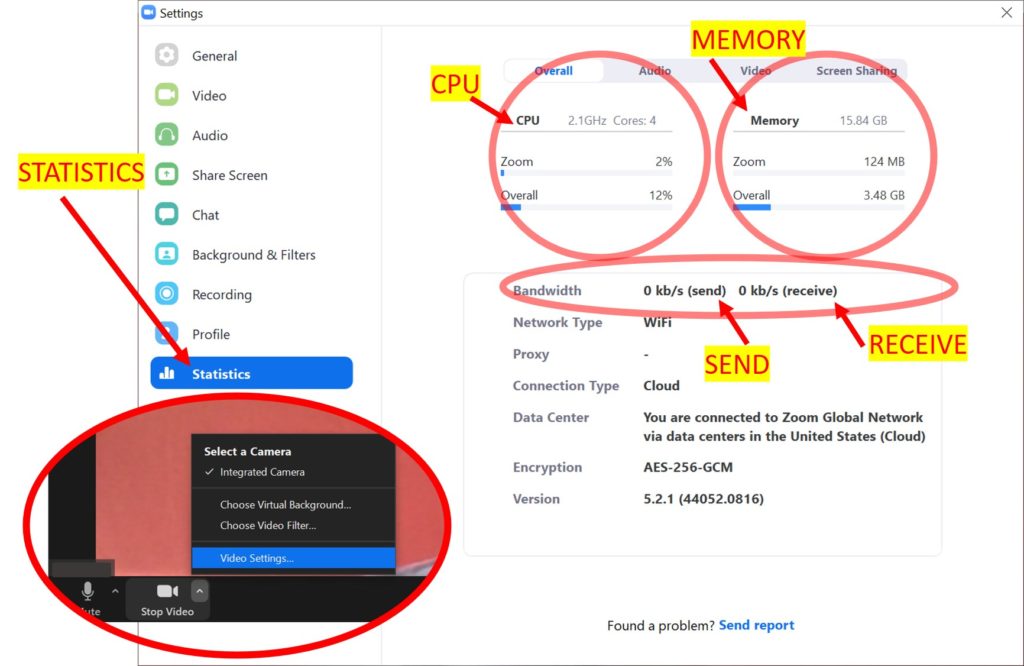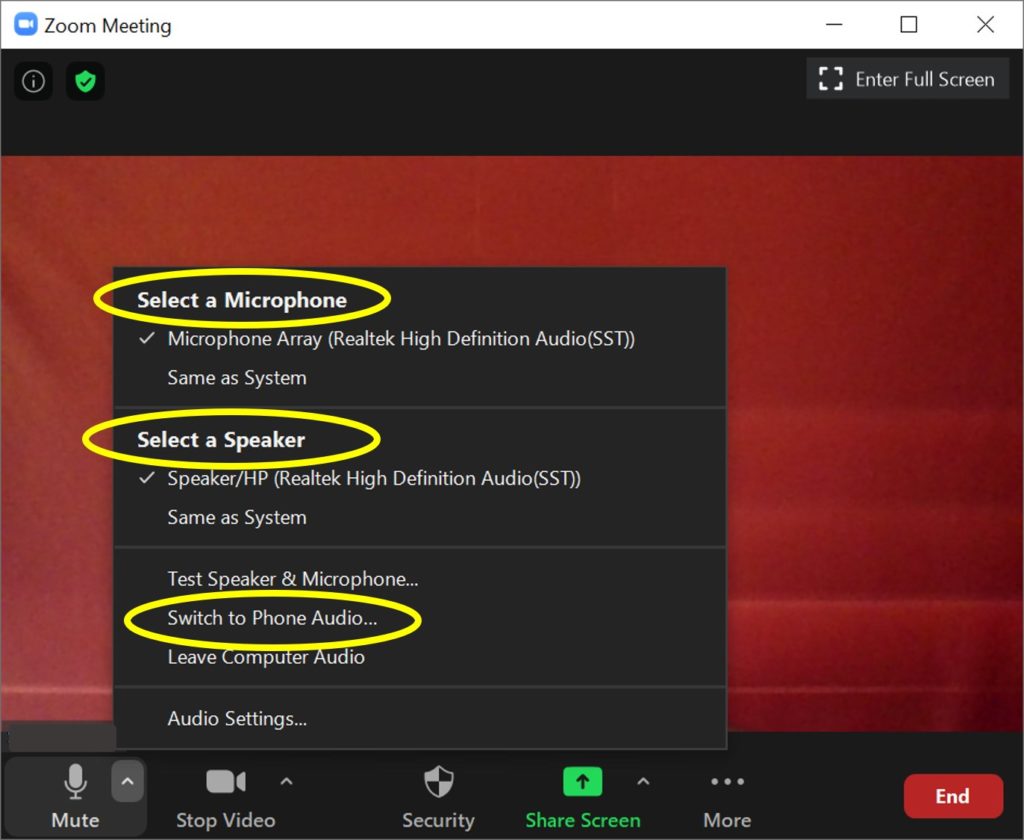Troubleshooting Zoom Audio
How To Get Zoom Audio Working Better
6 Simple Tips

6 Simple Tips
Follow these 6 simple tips for troubleshooting Zoom audio:
- Know your data usage! Look at the Statistics.
- Zoom meeting etiquette: talk or mute out.
- Try Headphones and/or a microphone
- Hide the video to improve data usage.
- Call in with the zoom audio phone number to improve data usage.
- It’s more about ping (signal delay) than bandwidth (Mbps)
Disclaimer: Dr Scott is not affiliated with Zoom. These are tips he has found to work well over years of online teaching. and Zoom education use. You may experience different results, depending on how you use Zoom. You just have to try a few things and see what works best.
Troubleshooting Zoom Audio
We strongly believe that having good Zoom audio is the most important aspect of an online classroom. We all need to be able to hear each other to communicate. Pretty much everything else is secondary when using Zoom for education.
We are not talking about just how to get Zoom audio to work. We are talking about how to get Zoom audio to work BETTER. Let’s assume you are connected. Here’s our tips for Zoom troubleshooting for audio.

Tip #1.
Know your data usage! Look at the Statistics.
This is the single most obvious, non-obvious thing about troubleshooting Zoom audio and video.
Stop guessing how much data it’s using. Because it tells you exactly how much data it’s using. At all times.
Find the Zoom Statistics.
Step 1: First you have to find the Video Settings… Probably in an arrow near the Stop Video button that you use to black our your video feed. Click into Video Settings… and it should bring up this window of Video Settings with about a dozen different sub menus.
Step 2: Click on Statistics. Look down a bit… find Bandwidth… It says (send) and (receive) in kbps or kb/s. Send means how much uploading you are doing, receive means how much downloading you are doing. It responds to any changes you make, so test out the below tips and see which actually improve your bandwidth situation!

Translating the Zoom Send/Receive Statistics
It’s all relative. Your internet connection needs to have more download bandwidth than you are recieving in Zoom. And your internet connection needs to have more upload bandwidth than you are sending in Zoom. Obvious, right? But how to check?
First, you need to know the speed of your internet connection. We like Speedtest.net. Go to Speedtest, click the GO button, it runs a test for a minute, and you get your download and upload speed, in Mbps. This is how much bandwidth your internet connection can provide, in both directions. And it needs to be more than Zoom is sending and receiving. Note that the speed of your internet connection may vary. Test it at several times a day (morning, noon, night) for a few consecutive days to be really sure. Don;t rely on what your internet provider (who you pay the bill to) says. Test it. Then test again to be sure.
Second, the Zoom Statistics are in kbps and the Speedtest,net results are in Mbbs. They are not directly comparable. Take the Zoom Statistics and divide by 1000, shifting an imaginary decimal point three positions to the left. For example, Zoom says it’s sending 444 kpbs, which sounds like a big number. This is only 0.444 Mbps, or less than half a “Meg” as we say colloquially.
For the record, standard “high speed internet” starts at 5-10 Megs (Mbps). A fiber optic network might have 50-100 Megs, and a corporate or university network could have a speed of hundreds of Megs. You can usually get away with using less than 1 Meg to operate Zoom. It’s not really as data heavy as users think, although it can get out of control for certain situations. You just have to keep an eye on the Zoom Statistics for all the different types of things you do in Zoom meetings.
Translating the Other Zoom Statistics
Also note the Zoom Statistics show usage for CPU (your computer chips) and Memory (your RAM). Look up top in the Zoom Statistics.
CPU and Memory usage is shown for Zoom as well as Overall (all programs running on your computer, including Zoom). If Zoom isn’t maxed out but you are Overall maxed out, then close some other programs.
As far as Memory goes, Zoom might want upwards of 2 Gigs (GB). That would be around 2,000 Megs as reported in the Zoom Statistics. (Add 3 zeros to Gigs to get Megs). Windows might also want around 2 Gigs. Most computers these days come with a minimum of 4 Gigs of RAM. So, theoretically, Zoom and Windows should fit. But maybe not much else, depending. Computers with 8 or 16 Gigs of RAM probably don’t need to worry about Memory.
CPU is usually not an issue for Zoom meetings. If, however, some program is using tons of CPU (like video editing) it could affect Zoom. Turn it off CPU intensive jobs (like video editing) during your Zoom meetings.

Tip #2.
Zoom Meeting Etiquette: Talk or Mute Out.
This is also fairly obvious. We cannot all talk at once. At least not if we intend to communicate.
In Zoom, however, you cannot just stop talking when it’s somebody else’s turn. You have to mute out. It’s an extra step that we don’t have in real life.
Background noise is weird. When the microphones aren’t muted, subtle background noises get picked up. The background noise can be transformed by the power of the internet into extremely annoying sounds. Usually, there is no harm intended, but it’s not obvious to the offender that they are allowing background noise into the system.
Err on the side of being polite. Mute out when not talking.
If somebody has truly excessive background noise that prevents their talking, there are other ways to communicate. Try the Chat, hand signals (real or digital), annotation features, etc. And after class, try to find a quieter place before the next Zoom meeting;)

Tip #3.
Try Headphones and/or a Microphone.
Bad Hardware
The software people said it’s a hardware problem. The hardware people said it’s a software problem. I said, “Grrr…”
A quick fix could simply be that your speakers or mic are broken. Or inadequate. You will never know until you test. Things break. Occasionally a new computer has a faulty mic.
We suggest to get a cheap pair of headphones with a mic built in. Two birds, one stone. First, test the equipment in a non-Zoom situation. Can you hear your favorite song with the headphones plugged in? Good start. Now test them in Zoom. Be sure that the new headphones/mic are already plugged in BEFORE starting Zoom, or you might have to reconfigure the Audio Options next to the Mute button (never fun). Does it make a difference?
Note the emphasis on getting a (relatively) cheap headphones/mic to test the premise that something is broken. We have never found that using expensive audio equipment helps. The problem is usually more basic.
Bad Software
Note that part about reconfiguring the Audio Options next to the Mute button (never fun). What’s really not fun is that occasionally Zoom sees your one microphone as two different mics. It’s a software thing, not a hardware thing. Under Select a Microphone, it might show a first microphone option plus Same as System or something like that. Try selecting the other microphone and see if it makes a difference. It might help. Same goes for the speaker.

Noisy Environment
The headphones and microphone can be especially useful if you are in a noisy environment. Have good Zoom meeting etiquette. If everybody is always complaining about background noise from your mic specifically, try a noise cancelling microphone. This can be really helpful for echos, which are often actual echos in the room you are in, not problems with Zoom or the internet.
Technically, you want a “directional” microphone. A directional, or noise canceling, microphone only transmit sounds that happen directly in front of it. That’s where your chest and mouth should be. (Pro tip: Point the mic moreso at your chest than your mouth!) So noises from other directions are cancelled, reducing the background noise in Zoom.
What you don’t want is an omnidirectional microphone. It transmits sounds from all directions, allowing lots of background noise to “leak in” from the sides, as they say in the music industry. So, for Zoom, think directional is good, omnidirectional is not good.

Tip #4.
Hide the Video to Improve Data Usage.
Improve Your Send (Upload)
Let’s assume that audio is more important than video. Can you sacrifice one for the other? Is there a tradeoff???
Stop asking and test! The answer is yes, by the way. In most cases, hiding the video will result in a lower send (upload) from Zoom. Check those Zoom Statistics (back to Tip #1) as you play with the Stop Video button.
You will also note that having a fixed background in Zoom will transmit less data. For example, if somebody is trying to screenshare a video playing while talking while showing their video feed… that’s a huge amount of data. What’s behind you? A non-moving wall or a scene of bustling action? Because of the way video compression works, it takes less data to transmit less motion.
Most importantly, having the screen share (Share Screen) on reduces the video feed size. This drastically reduces Zoom send/upload.
Improve Your Receive (Download)
Watching the other video feeds in the Zoom meeting requires more download (Zoom receive). To use less data, view less. Hear more!
The first thing is how many video feeds you are watching. You can see none, one, a column/row, or a grid of even more feeds. Make sure you know how to adjust the number of video feeds (faces) you see. Zoom automatically switches the camera to the person talking, so you don’t always need to see everybody all the time. This is assuming non-talkers are muted, another strong reason to promote Zoom meeting etiquette.
The second thing is how big the video feeds are. You can always drag the video feed window from a corner to adjust the size. Bigger video feeds require more downloading. Smaller video feeds could help your bandwidth (check for yourself!), and improve the audio.
If you want to hear the teacher in a Zoom class, pay extra attention to this part about receiving. It’s maybe the most important advice for troubleshooting Zoom audio. You want to receive audio clearly. Every pixel of video feed you receive is competing with receiving the teacher’s voice. The solution is to minimize the number of pixels of video feeds you see. Display fewer, smaller video feeds to receive the audio better.

Tip #5.
Call in with the Zoom Audio Phone Number to Improve Data Usage.
This is a really old-school trick!
Remember telephones? Before voice came over internet transmissions?
You can still call in for audio, using an actual telephone to call an actual phone number. Ask the meeting host. Usually there are several phone numbers, per country, provided per meeting. Often one doesn’t work and some others do. Try them. Note it could be a long distance or even international call. Make sure you understand how your phone billing works before, say, you make a 1-hour call to New York City to connect to the audio for a Zoom class.
Note this totally eliminates the possibility that bad internet is affecting your audio! Obviously, though, you need a good, stable phone line for this to work. Remember that silly landline telephone those telecom companies are always trying to bundle with your internet? Perhaps a telephone could once again be useful.
Where is it found? Check out the image under Tip #3 above showing the Audio Options.

Tip #6.
It's More About Ping (Signal Delay) than Bandwidth (Mbps).
What's your ping?
Go back to Tip #1, testing the speed of your internet connection using Speedtest.net. There is something WAY more important than your download and upload speed, in Mbps. We didn’t mention this earlier.
Look at the Ping, in ms (milliseconds). This is how many milliseconds your internet connection takes to send a message and get back a response. It’s the delay in the Zoom meeting due to delays in the internet. Nothing is instant, everything takes time. And the internet is no different. It just seems to be in real time. There is a slight delay that we usually don’t notice. With a lot of delay (high ping), the video gets choppy and annoying, and the audio can be garbled beyond recognition.
What's a Good Ping?
We suggest that ping under about 75 ms is awesome. A modern fiber optic network might have a single digit ping, which is seemingly instant. For pings above 100 ms, the audio starts to degrade. It can be made to work at 150 ms ping. For pings above 300 ms, which is about one third of one second, the technology seems to fail.
So, what’s your ping? If your ping is really bad, it’s probably just an isolated event. A bad internet day. Don’t worry. The internet isn’t perfect.
If your ping is always bad, though, you might need to consider a technology upgrade to get Zoom audio working better. This is truly the case that your internet connection speed is limiting your experience. In our experience, the issue is usually ping and not your upload/download speed, assuming you try the above 5 tips first.
Summary for Troubleshooting Zoom Audio
Troubleshooting Zoom audio isn’t tricky. You just need to use the wonderful Statistics that they already give you. Try the above tips, and see what works to improve your Zoom education experience.
A key idea here is that there is a tradeoff between video and audio. You can generally sacrifice one to improve the other. How much would it help? You just have to test the strategies mentioned above, keeping an eye on the Statistics as well as your experience. Does your Zoom class seem better now? Did that tweak help??
Technology usually isn’t the issue. You can make Zoom work if you have:
- a reasonably stable internet connection (under 150 ms ping),
- a reasonably modern computer (at least 4 GB memory), and
- non-broken speakers and mic.
Just picture the very first time that your grandparents picked up a cell phone, not a corded phone. Now, that’s you, trading up your cell phone for full blown video chat. You’ll get this, You just need to try out a few options.

